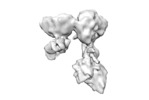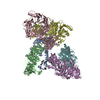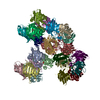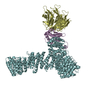[English] 日本語
 Yorodumi
Yorodumi- EMDB-11017: CTC-primase, body 1 (contains primase, CIAO1, CIAO2B, MMS19 CTD) -
+ Open data
Open data
- Basic information
Basic information
| Entry | Database: EMDB / ID: EMD-11017 | ||||||||||||
|---|---|---|---|---|---|---|---|---|---|---|---|---|---|
| Title | CTC-primase, body 1 (contains primase, CIAO1, CIAO2B, MMS19 CTD) | ||||||||||||
 Map data Map data | |||||||||||||
 Sample Sample |
| ||||||||||||
| Biological species |  Homo sapiens (human) Homo sapiens (human) | ||||||||||||
| Method | single particle reconstruction / cryo EM / Resolution: 8.8 Å | ||||||||||||
 Authors Authors | Kassube SA / Thomae N | ||||||||||||
| Funding support |  Switzerland, 3 items Switzerland, 3 items
| ||||||||||||
 Citation Citation |  Journal: Nat Struct Mol Biol / Year: 2020 Journal: Nat Struct Mol Biol / Year: 2020Title: Structural insights into Fe-S protein biogenesis by the CIA targeting complex. Authors: Susanne A Kassube / Nicolas H Thomä /  Abstract: The cytosolic iron-sulfur (Fe-S) assembly (CIA) pathway is required for the insertion of Fe-S clusters into cytosolic and nuclear client proteins, including many DNA replication and repair factors. ...The cytosolic iron-sulfur (Fe-S) assembly (CIA) pathway is required for the insertion of Fe-S clusters into cytosolic and nuclear client proteins, including many DNA replication and repair factors. The molecular mechanisms of client protein recognition and Fe-S cluster transfer remain unknown. Here, we report crystal structures of the CIA targeting complex (CTC), revealing that its CIAO2B subunit is centrally located and bridges CIAO1 and the client adaptor protein MMS19. Cryo-EM reconstructions of human CTC bound either to the DNA replication factor primase or to the DNA helicase DNA2, combined with biochemical, biophysical and yeast complementation assays, reveal an evolutionarily conserved, bipartite client recognition mode facilitated by CIAO1 and the structural flexibility of the MMS19 subunit. Unexpectedly, the primase Fe-S cluster is located ~70 Å away from the CTC reactive cysteine, implicating conformational dynamics of the CTC or additional maturation factors in the mechanism of Fe-S cluster transfer. | ||||||||||||
| History |
|
- Structure visualization
Structure visualization
| Movie |
 Movie viewer Movie viewer |
|---|---|
| Structure viewer | EM map:  SurfView SurfView Molmil Molmil Jmol/JSmol Jmol/JSmol |
| Supplemental images |
- Downloads & links
Downloads & links
-EMDB archive
| Map data |  emd_11017.map.gz emd_11017.map.gz | 1.6 MB |  EMDB map data format EMDB map data format | |
|---|---|---|---|---|
| Header (meta data) |  emd-11017-v30.xml emd-11017-v30.xml emd-11017.xml emd-11017.xml | 8.8 KB 8.8 KB | Display Display |  EMDB header EMDB header |
| Images |  emd_11017.png emd_11017.png | 43 KB | ||
| Archive directory |  http://ftp.pdbj.org/pub/emdb/structures/EMD-11017 http://ftp.pdbj.org/pub/emdb/structures/EMD-11017 ftp://ftp.pdbj.org/pub/emdb/structures/EMD-11017 ftp://ftp.pdbj.org/pub/emdb/structures/EMD-11017 | HTTPS FTP |
-Validation report
| Summary document |  emd_11017_validation.pdf.gz emd_11017_validation.pdf.gz | 198.5 KB | Display |  EMDB validaton report EMDB validaton report |
|---|---|---|---|---|
| Full document |  emd_11017_full_validation.pdf.gz emd_11017_full_validation.pdf.gz | 197.6 KB | Display | |
| Data in XML |  emd_11017_validation.xml.gz emd_11017_validation.xml.gz | 5.5 KB | Display | |
| Arichive directory |  https://ftp.pdbj.org/pub/emdb/validation_reports/EMD-11017 https://ftp.pdbj.org/pub/emdb/validation_reports/EMD-11017 ftp://ftp.pdbj.org/pub/emdb/validation_reports/EMD-11017 ftp://ftp.pdbj.org/pub/emdb/validation_reports/EMD-11017 | HTTPS FTP |
-Related structure data
- Links
Links
| EMDB pages |  EMDB (EBI/PDBe) / EMDB (EBI/PDBe) /  EMDataResource EMDataResource |
|---|
- Map
Map
| File |  Download / File: emd_11017.map.gz / Format: CCP4 / Size: 20.8 MB / Type: IMAGE STORED AS FLOATING POINT NUMBER (4 BYTES) Download / File: emd_11017.map.gz / Format: CCP4 / Size: 20.8 MB / Type: IMAGE STORED AS FLOATING POINT NUMBER (4 BYTES) | ||||||||||||||||||||||||||||||||||||||||||||||||||||||||||||||||||||
|---|---|---|---|---|---|---|---|---|---|---|---|---|---|---|---|---|---|---|---|---|---|---|---|---|---|---|---|---|---|---|---|---|---|---|---|---|---|---|---|---|---|---|---|---|---|---|---|---|---|---|---|---|---|---|---|---|---|---|---|---|---|---|---|---|---|---|---|---|---|
| Projections & slices | Image control
Images are generated by Spider. | ||||||||||||||||||||||||||||||||||||||||||||||||||||||||||||||||||||
| Voxel size | X=Y=Z: 1.74 Å | ||||||||||||||||||||||||||||||||||||||||||||||||||||||||||||||||||||
| Density |
| ||||||||||||||||||||||||||||||||||||||||||||||||||||||||||||||||||||
| Symmetry | Space group: 1 | ||||||||||||||||||||||||||||||||||||||||||||||||||||||||||||||||||||
| Details | EMDB XML:
CCP4 map header:
| ||||||||||||||||||||||||||||||||||||||||||||||||||||||||||||||||||||
-Supplemental data
- Sample components
Sample components
-Entire : MMS19-CIAO1-CIAO2B-primase complex
| Entire | Name: MMS19-CIAO1-CIAO2B-primase complex |
|---|---|
| Components |
|
-Supramolecule #1: MMS19-CIAO1-CIAO2B-primase complex
| Supramolecule | Name: MMS19-CIAO1-CIAO2B-primase complex / type: complex / ID: 1 / Parent: 0 |
|---|---|
| Molecular weight | Theoretical: 164.211 KDa |
-Supramolecule #2: MMS19 CTD-CIAO1-CIAO2B CIA targeting complex
| Supramolecule | Name: MMS19 CTD-CIAO1-CIAO2B CIA targeting complex / type: complex / ID: 2 / Parent: 1 |
|---|---|
| Source (natural) | Organism:  Homo sapiens (human) Homo sapiens (human) |
| Recombinant expression | Organism:  Trichoplusia ni (cabbage looper) Trichoplusia ni (cabbage looper) |
-Supramolecule #3: Primase
| Supramolecule | Name: Primase / type: complex / ID: 3 / Parent: 1 |
|---|---|
| Source (natural) | Organism:  Homo sapiens (human) Homo sapiens (human) |
| Recombinant expression | Organism:  |
-Experimental details
-Structure determination
| Method | cryo EM |
|---|---|
 Processing Processing | single particle reconstruction |
| Aggregation state | particle |
- Sample preparation
Sample preparation
| Concentration | 0.3 mg/mL |
|---|---|
| Buffer | pH: 7.4 |
| Vitrification | Cryogen name: ETHANE |
- Electron microscopy
Electron microscopy
| Microscope | FEI TITAN KRIOS |
|---|---|
| Image recording | Film or detector model: FEI FALCON II (4k x 4k) / Average electron dose: 50.0 e/Å2 |
| Electron beam | Acceleration voltage: 300 kV / Electron source:  FIELD EMISSION GUN FIELD EMISSION GUN |
| Electron optics | Illumination mode: FLOOD BEAM / Imaging mode: BRIGHT FIELD |
| Experimental equipment |  Model: Titan Krios / Image courtesy: FEI Company |
- Image processing
Image processing
| Startup model | Type of model: EMDB MAP EMDB ID: |
|---|---|
| Final reconstruction | Resolution.type: BY AUTHOR / Resolution: 8.8 Å / Resolution method: FSC 0.143 CUT-OFF / Number images used: 42382 |
| Initial angle assignment | Type: OTHER |
| Final angle assignment | Type: MAXIMUM LIKELIHOOD |
 Movie
Movie Controller
Controller

















 Z (Sec.)
Z (Sec.) Y (Row.)
Y (Row.) X (Col.)
X (Col.)





















